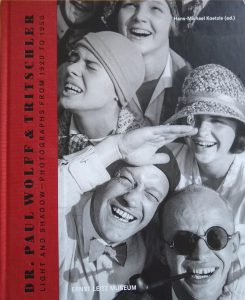Dr. Paul Wolff’s association with Leica culminated in the 1934 publication Meine Erfahrungen mit der Leica.The chapter, “Liberation from Handed-Down Traditions” provides information on Dr. Paul Wolff’s Leica-related work and on how Wolff came to be a role-model to Leica amateurs.
Dr. Paul Wolff & Tritschler. Light and Shadow – Photographs from 1920 to 1950. © 2019 Kehrer Verlag Heidelberg Berlin, authors, artists and photographers [and translator]. ISBN 978-3-86828-881-0
Dr. Paul Wolff’s association with the Leica camera
Published at Kehrer Verlag. Editor Hans-Michael Koetzle. Translator Alexandra Cox. The respective word count in the book is indicated for each essay (for reasons of concision, I omit the endnotes, but they are included in the word count).
From: Liberation from Handed-Down Traditions
Dr. Paul Wolff’s association with the Leica camera Dr. Paul Wolff’s Leica-related work Leica amateurs
Paul Wolff as “Pioneer of the Leica” and Trailblazer of 35-mm Practice
by Hans-Michael Koetzle. Translated from German by Alexandra Cox.
9,873 words
Dr. Paul Wolff’s Experience in Book Form
Meine Erfahrungen mit der Leica was published in 1934 by the H. Bechholdsche Verlagsbuchhandlung in Frankfurt am Main, and marked the beginning of a successful collaboration with the tradition-steeped institution that was to span several Leica titles—Skikamerad Toni (1936), Sonne über See und Strand (1936), Großbild oder Kleinbild? (1938), Meine Erfahrungen … farbig (1942). The “overall artistic layout” was the responsibility of the graphic designer Hans Breidenstein, whom Wolff had met already in the context of a company publication for the Adlerwerke. Meine Erfahrungen mit der Leica was by no means the first “guide” to the novel camera. Particularly worthy of mention, for example, is Curt Emmermann and his highly successful book, published at Knapp in Halle in 1930, Photographieren mit der Leica (later Leica-Technik). But what distinguished Wolff’s work not only from Emmermann’s, but also from publications by Fritz Vith or Hans Windisch, was the personal form of address, the wealth of experience that the title already announces—“everything that he writes down has been lived through and experienced”—the whole supported by a richly faceted visual program that had not been simply purchased and put together, as was the case with many other anthologies published at the same time, but was the outcome of the work of many years of a single photographing author. Wolff also trod new paths by merging the genre of guide with the genre of vacation or travel book (Skikamerad Toni, Sonne über See und Strand, Groß-Bild oder Klein-Bild?, Kleine Italienfahrt). Added to this were the comparatively stout book format, the exquisite fitting-out with black cut and matching endpaper, the dazzling quality of the reproductions in variegated copper gravure, while—as Wolff stresses in the introduction—it is probably the first time that “the attempt has been made” to “make gravure etchings in a very large format directly after the small negatives, so not in a roundabout manner via an existing enlargement”. In terms of formal aesthetics, Wolff absolutely followed the dictates of a new photography featuring unusual perspectives, steep views from above or below, motion studies, or night shots, without, however, occasioning the visual vocabulary to venture too far onto experimental terrain. He was “no friend of oblique perspectives”, he writes in Meine Erfahrungen mit der Leica, where he permitted himself, rather exceptionally, “oblique views” or a “photograph from the supine position”. His intention was not to compete with an avant-garde that had been taking shape since the mid-1920s, but to act as a role-model to a growing crowd of Leica amateurs.
(… … )
Dr. Paul Wolff & Trischler. Light and Shadow – Photographs from 1920 to 1950 comprises 14 chapters in total, all translated by Alexandra Cox.
